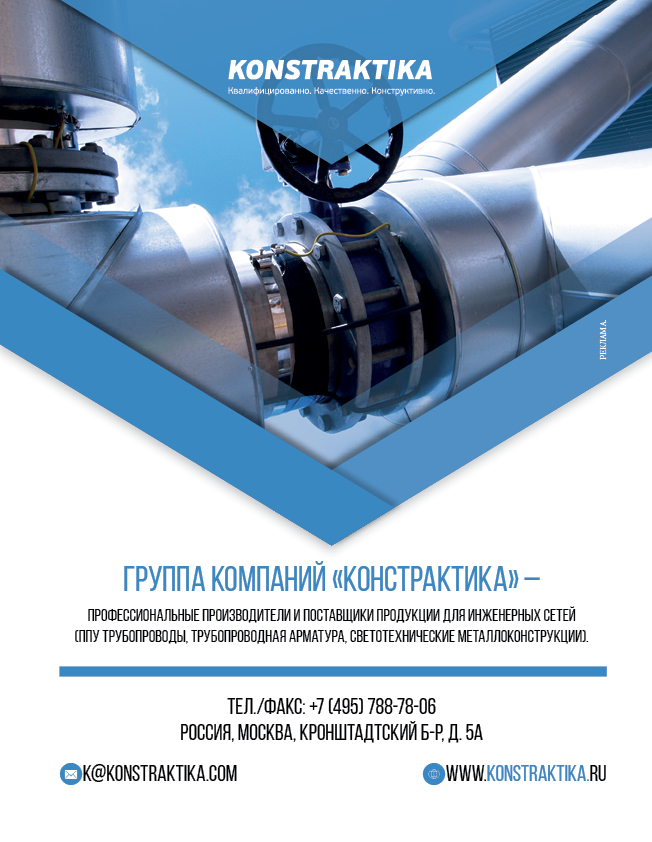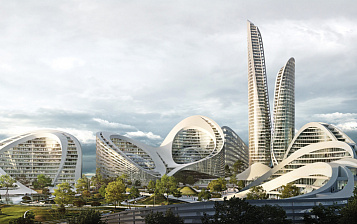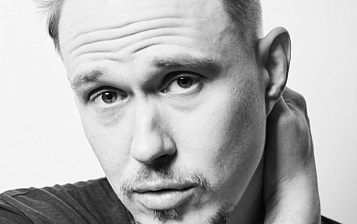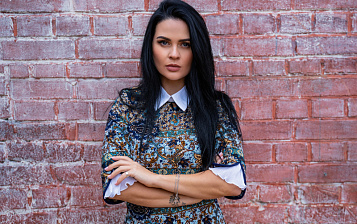An interesting fact, according to statistics, Russians more often traveled to Egypt, Germany, Turkey, Spain, Thailand, the USA in pre-COVID times, but according to a survey by the NAFI analytical center, in September 2020 they most often dream of a trip to Italy. Other polls confirm this. We are very different, but we love Italian architecture and atmosphere in general. Someone more - Lake Camo, someone Tuscany with their vineyards, someone colonnades of Renaissance architecture. In conditions when the whole world is covered by the second wave of the coronavirus pandemic, there is no hope for an early opening of borders. In the last issue, we wrote about domestic tourism in Russian regions, but even while in Moscow, you can dive into the images of Italy, fortunately, if you believe the historians of architecture, there are many of them. The special correspondent of the Gorproekt magazine, Maxim Kirsanov, having read about Rome (see Gorproject dated 06.2020), found numerous traces of it in the capital at various levels of historical layers.
Architectural historian Andrei Barkhin, who studied how Italy penetrated the capital in a variety of ways, helped us figure out why Italy is the most on the streets of Belokamennaya.
Adventures of Italians in Russia
Actually, it would not be an exaggeration to say directly that Moscow in its present form began with massive Italian influence. Moreover, the initiative was largely mutual. By the end of the 15th century, when the Muscovite kingdom united the Russian lands and put an end to Mongol domination, Italian architects were already in vogue around the world, but they were also extremely curious about the distant northern country, where they could turn around with the most daring ideas. If we stand on Cathedral Square inside the Kremlin, then wherever you look - the work of Italians. So, Aristotle Fioravanti built the Assumption Cathedral. Today it is the oldest completely preserved stone building in the city with characteristic Italian mini-columns, as in the architect's native Bologna. Even brick and cladding Aristotle produced according to Italian technology. Following him, Marco Ruffo, Pietro Antonio Solari, Antonio Gilardi, Aleviz Stary and many other "fryazi" built temples, towers and walls of the Kremlin, the Faceted Chamber, and other objects. As art historians note, the Archangel Cathedral with characteristic “shells” and floral ornaments, if you remove the domes, is indistinguishable from the Venetian palazzos of those times. The characteristic "dovetail" of the famous teeth of the Kremlin can be found on numerous castles in Northern Italy - from Verona (Castelvecchio) to the fortresses of the Scaligers. These characteristic teeth emphasized belonging to the Ghibelline party, which fought against the power of the Pope - a very suitable definition for the "Third Rome" as well. But only for Russian money, the Italians were able to make one of the largest projects in history - after all, the Kremlin area is 28 hectares, larger than Windsor and Prague Castle.
The various turrets of the Moscow Kremlin have their prototypes in Milan's Sforza castle (compare its Filarete and Spasskaya towers), which were also occupied by the same Fioravanti and Solari.
Then the Italian fortification traditions were continued by Petrok Maly, who transferred the medieval Italian traditions in the Kitaigorod wall, and brought Orthodox architecture closer to the Gothic in the Church of the Ascension and St. George in Kolomenskoye.
Campaign, he invented the "tent style" of Orthodox stone architecture, which for almost a century was the hallmark of Muscovy. And then it started. Traces of Florentine temples, including the Duomo, can be found in the Simonov Monastery and many other buildings of medieval Moscow. The next wave of Italian architects followed already in the 18th century, when Giovanni Fontana, Pietro Trezzini (the author of the most luxurious baroque church in Moscow in Zamoskvorechye, dedicated to Pope Clement), the great Rastrelli (who became a co-author of the New Jerusalem), Francesco Camporesi (co-author of the palaces on Bolshaya Lubyanka and Myasnitskaya), Giacomo Quarenghi (author of Lefortovsky, Sloboda, Sheremetevsky, Ostankino palaces and Gostiny Dvor with 108 columns), Giuseppe Bove.
The latter changed his name to the Russian Osip and gave us the Novo-Ekaterininskaya Hospital, the Manege and, of course, the Maly Bolshoi Theatre. It is characteristic that all these objects of the master have become so important for the self-determination of Moscow that their reconstruction in the 21st century has become a powerful national project, for which the best PSK formwork systems were produced and the most innovative technologies of their time were introduced.
Despite the fact that in the 19th century Russia stopped inviting foreign architects en masse, Italian influence broke even through the waves of “pseudo-Byzantine” eclecticism. It can be seen at the Hippolyte Monnigueti Polytechnic Museum, renovated in 2020. The influence of Milan's main department store (Gallery Victor Emmanuel II) is felt in Moscow's GUM. But the ethnic Italians were replaced by architects Italian in spirit. And their influence on Moscow turned out to be great already in the 20th century.
Russian architects with Italy in their soul
It all started with the peculiarities of architectural education in imperial Russia, which involves many months, and sometimes even many years of travel around Europe. The genius of Russian Art Nouveau, Fyodor Osipovich Shekhtel, in his youth, annually made a big trip around Europe, primarily through all of Italy: from Milan and Venice to Naples and Sicily. It is not surprising that Maxim Gorky, who lived in Capri for many years, chose the mansion built by Shekhtel with characteristic southern Mediterranean motifs (the former owners of the mansion, the Ryabushinsky family, on the contrary, left the Soviet regime for Italy). From the very beginning of the 20th century, the future Pushkin Museum im. Pushkin, which is based on copies of Italian classics (starting with David), models of cathedrals and originals of the “old masters” starting from the Renaissance. It is not surprising that at the beginning of the 20th century, when it seemed closer to the revolution of 1917, and even more so after it, that modernity and avant-garde won in the architectural community of Moscow and a reverse trend was naturally outlined: towards Italian classics. Several generations of architects who were educated in the Russian Empire at once were not only inspired by Italy and lived there a lot (for example, Ivan Zholtovsky visited the Apennines 26 times, often staying for years, he was also accompanied by the author of the General Plan for the Reconstruction of Moscow, Sergey Yegorovich Chernyshev), but and have seen how the Italian tradition is gaining popularity all over the world. For example, Vyacheslav Oltarzhevsky, co-author of the Stalinist skyscrapers and pavilions at VDNH, saw, having worked in the USA in the 1920s, that copying the masters of the Renaissance with their colonnades and complex orders is a current trend in world architecture. It is not surprising that after the political defeat of the avant-gardists, with whom the neoclassicist Trotsky who fled the country was associated - often verbatim quotes from Italian architecture - became the canon of Soviet urbanism for a long time. Unlike isolated cases of the past - for example, Michelangelo's quotes in the Pashkov House - now it was not about single monuments, but about the mass restructuring of the entire city under Soviet Rome.
Fast forward again to Manezhnaya Square near the walls of the Kremlin - next to the works of Fioravanti and Beauvais stands a mighty colonnade, an almost complete copy of the loggia del Capitanio in Vicenza by Andrea Palladio, interspersed with elements of the Church of San Giorgio Maggiore.
It was in this mansion on Mokhovaya that the residence of the US ambassador was located, whose parties of the 1930s are believed to have been described by Bulgakov at his "Satan's Ball". The creator of this seemingly Renaissance masterpiece, Ivan Vladislavovich Zholtovsky, according to the then avant-garde artists (for example, Vesnin), drove a nail into the coffin of the constructivism of the 1920s. Modern historians look more conciliatory, in their opinion, he created "harmonized constructivism", where panoramic windows and elevators successfully coexisted with giant columns, stucco and numerous quotes "for connoisseurs". There were so many of the latter that one can speak of copying a large layer of the Italian Renaissance, Quattrocente and even antiquity in the architecture of Stalinist Moscow. As in Rome or Venice, since the 1930s, development has been in blocks, mighty architectural ensembles that now attract tourists from all over the world. But every house of the Soviet neoclassicists is a whole bunch of "memories of Italy." According to Andrey Barkhin, Zholtovsky and his students often literally transferred 500-year-old Italian architecture to the new Soviet capital. Characteristic Italian palace "rust" (facing) of the first floors in the spirit of Florence, turning into exquisite architraves, as if from Venice, Pompeian columns and mosaics on Soviet subjects, but stylistically almost indistinguishable from the originals of 2000 years ago.
On the one hand, we got eclecticism, but contrary to popular belief, not “baroque”, but hard-classicism with specific quotes, where inside a residential building on Smolenskaya Square (house 11) you can find a Roman palazzo and only a slightly reduced bell tower of San Marco from Venice. Often, since employees of the NKVD and the CPSU lived in such houses, this art is called "totalitarian", "Stalinist", unnecessarily "southern", but it originated in Russian architecture long before the revolution and Georgians in the leadership of the Party, in a natural way, which we described higher. Tarasov's house on Spiridonovka (1912) copied the Palladian Palazzo Thiene when it was not fashionable. Also, before the revolution, when everyone was fond of gothic “under-England”, in the neoclassical style, Zholtovsky built a hippodrome on Begovaya, which is indistinguishable from the later “Stalinist” complexes. Because there was no “Stalinist” architecture, but there were neoclassical schools of Italian fans who were lucky to become massive. But the opposite is also true - even when Soviet politicians cooled off towards neoclassicism - fans of Italy continued to elegantly insert references to their beloved country even in simplified versions of their projects, for example, in the new building of the Stroganov Academy in particular (and in general during the development of Volokolamka and Leningradka). We will not list all the signs of Rome in Moscow that these sincere fans of the Renaissance, who were lucky enough to be in the right place at the right time, gave us. Those who wish will find a copy of the Roman pantheon at the Park Kultury metro station, references to the tomb of the Roman baker Evrisak from Porta Maggiore in the Chistye Prudy area, the ancient Roman-style MOGES boiler house opposite Zaryadye, and numerous Italian motifs of the Patriarchs. Even the simplest guides to Moscow list dozens of bright Soviet objects with “Italian” roots.”
Yes, the Bolsheviks destroyed a lot of priceless things starting with the Sukharevskaya Tower, but they also gave us the opportunity to appreciate the Italian palazzo, real medieval palaces, miraculously transferred and adapted for Soviet citizens and us, their descendants. Many philosophers, starting with Weil's "genius of place" and Boris Groys' "art of utopia", ask themselves what it was - why for several decades Russians were asked to represent themselves as inhabitants of the Mediterranean. We will not give you an answer, but the fact that these large-scale quarters have their own historical value is undeniable.
Among the latest evidence is the restoration of the Northern River Station in Moscow in 2020 (and the adjacent neoclassical park, also reconstructed with formwork and PSK technique), another neoclassical monument that combined the motifs and elements of the Doge's Palace from Venice, the facades of the Cremona Cathedral and the general the spirit of Andrea Palladio, who believed that ordinary people deserve to live near ancient temples and majestic palaces.
Italian modernity in Moscow
We wrote a lot about the restoration of monuments with Italian roots in Moscow, but it can be said without exaggeration that the tradition of building new allusions to Italy has not been interrupted in the capital in the 21st century. Among the successful development projects of recent years are Rimsky residential complex, Brodsky residential complex and the huge "Italian Quarter" in the Novoslobodskaya area with references to the silhouettes of the Colosseum. Neoclassicism has not been mainstream for a long time, but continues to be in demand in many premium projects, when they are built not just for making money, but “for centuries”: from the Radisson Hotel on the site of Intourist to country houses on Nikolina Gora, where the neoclassical architect Mikhail Filippov promotes the arrangement of ancient Roman villas as optimal for a break from the metropolis.
In the center of Moscow, meanwhile, just like hundreds of years ago, Italian architects set quality standards.
The co-author of the Pompidou Center in Paris, the architect Renzo Piano, is completing in 2020 the reconstruction of HPP-2 opposite Red October, where the motifs of aqueducts and amphitheaters are mixed. A block away, Massimo José Ghini and Vesper show how a deluxe renovation can be done in their new Cloude Nine project across the bridge from the Kremlin.
As we can see, even after more than 5 centuries, after the beginning, the Italian presence in Moscow is not weakening.
Proof of this is the well-known opinion about Gogol: Nikolai Vasilyevich loved Rome most of all, which he was ready to exchange only for Moscow. And this is no coincidence. Italian alloys in architecture, even in the most troubled times, whether industrialization or a pandemic, can mentally take us somewhere to the south, to the harmony of arches and colonnades, where it is warmer and just calmer.


 DOWNLOAD
DOWNLOAD LOOK
LOOK
 Top Content of the Month
Top Content of the Month


